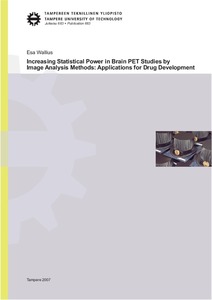Increasing statistical power in brain PET studies by image analysis methods: applications for drug development
Wallius, E. (2008)
Wallius, E.
Tampere University of Technology
2008
Tieto- ja sähkötekniikan tiedekunta - Faculty of Computing and Electrical Engineering
This publication is copyrighted. You may download, display and print it for Your own personal use. Commercial use is prohibited.
Julkaisun pysyvä osoite on
https://urn.fi/URN:NBN:fi:tty-200810021090
https://urn.fi/URN:NBN:fi:tty-200810021090
Tiivistelmä
This thesis provides means to increase the statistical power of analysis in brain positron emission tomography (PET) neuroreceptor studies. Despite its importance, this topic has remained relatively unexplored. The most obvious way to enhance the power is to increase the sample size, i.e. the number of observations. However, with PET, there are both financial (high cost of a study) and ethical reasons (radiation dose to the patient) that restrict substantial increase in the sample size.
We searched for ways to increase the statistical power in the analysis of PET brain studies by decreasing the measurement error (specifically, variation due to the measurement process) as well as by using a sensitive statistical technique of analysis. Our procedure was as follows: firstly, we reduced probably the greatest source of variation - the manual steps - by introducing an entirely automatic method for region-of-interest delineation. Secondly, we performed phantom simulations to determine the combination of image reconstruction methods and physiological model calculation methods that produced the least variation (and bias). Thirdly, we applied a statistical method which produces satisfactory statistical power with a very limited sample size. In the first two methods, we showed the enhancement in power by the better reproducibility and reliability, as well as lower variability, of the methods we applied. In the third method, the gain in power was illustrated by comparing the results with the standard method of analysis. If all three methods are performed, it may be possible to get satisfactory statistical power even with a limited sample size and possibly restrict the sample size even more.
Our application was in PET receptor occupancy studies, which have been found to be useful in guiding the dose-finding procedures in early drug development. In addition to the gain in power to detect the effects of a drug, cost savings and an increase in speed can be achieved with the methods introduced in this thesis. The cost savings relate to pre-planning: realistic simulations with numerical dynamic phantoms may save many expensive pilot PET studies on humans. The increase in speed was obtained by automation of the region-of-interest delineation.
We searched for ways to increase the statistical power in the analysis of PET brain studies by decreasing the measurement error (specifically, variation due to the measurement process) as well as by using a sensitive statistical technique of analysis. Our procedure was as follows: firstly, we reduced probably the greatest source of variation - the manual steps - by introducing an entirely automatic method for region-of-interest delineation. Secondly, we performed phantom simulations to determine the combination of image reconstruction methods and physiological model calculation methods that produced the least variation (and bias). Thirdly, we applied a statistical method which produces satisfactory statistical power with a very limited sample size. In the first two methods, we showed the enhancement in power by the better reproducibility and reliability, as well as lower variability, of the methods we applied. In the third method, the gain in power was illustrated by comparing the results with the standard method of analysis. If all three methods are performed, it may be possible to get satisfactory statistical power even with a limited sample size and possibly restrict the sample size even more.
Our application was in PET receptor occupancy studies, which have been found to be useful in guiding the dose-finding procedures in early drug development. In addition to the gain in power to detect the effects of a drug, cost savings and an increase in speed can be achieved with the methods introduced in this thesis. The cost savings relate to pre-planning: realistic simulations with numerical dynamic phantoms may save many expensive pilot PET studies on humans. The increase in speed was obtained by automation of the region-of-interest delineation.
Kokoelmat
- Väitöskirjat [4773]
